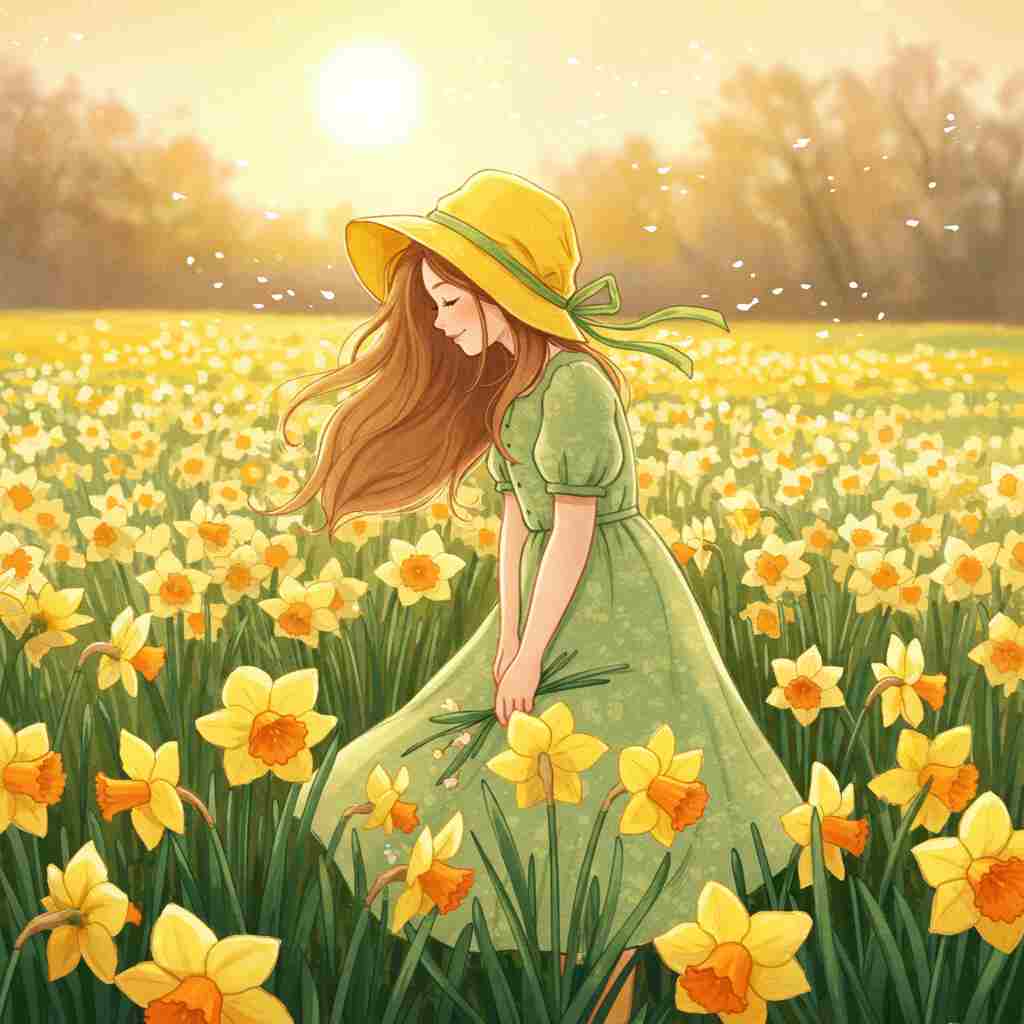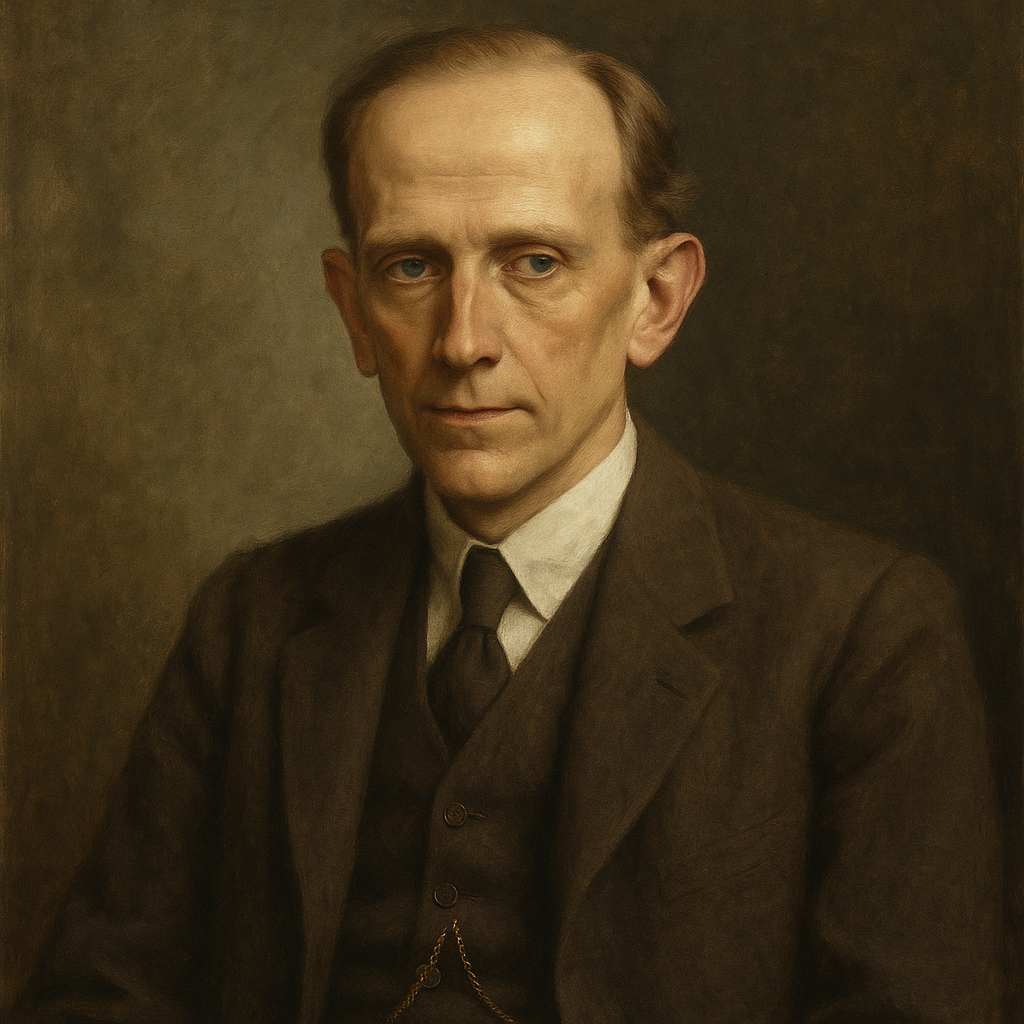Daffodowndilly
A. A. Milne
1882 to 1956

She wore her yellow sun-bonnet,
She wore her greenest gown;
She turned to the south wind
And curtsied up and down.
She turned to the sunlight
And shook her yellow head,
And whispered to her neighbour:
"Winter is dead."
A. A. Milne's Daffodowndilly
A. A. Milne, best known for his beloved Winnie-the-Pooh stories, was also a gifted poet whose works for children possess a deceptive simplicity that belies their deeper thematic and emotional resonance. "Daffodowndilly," a brief yet evocative poem, exemplifies Milne’s ability to imbue natural imagery with vitality, personifying the daffodil as a harbinger of spring and renewal. Through its delicate interplay of anthropomorphism, seasonal symbolism, and rhythmic charm, the poem transcends mere children’s verse, offering instead a meditation on cyclical rebirth and the triumph of life over winter’s desolation. This analysis will explore the poem’s literary devices, thematic concerns, historical and biographical context, and emotional impact, demonstrating how Milne crafts a work that is at once whimsical and profound.
Personification and the Vitality of Nature
The most striking feature of "Daffodowndilly" is its personification of the daffodil, which is rendered not merely as a flower but as a graceful, almost coquettish figure engaging in a ritualistic celebration of spring. The opening lines—
She wore her yellow sun-bonnet,
She wore her greenest gown—
immediately establish the flower as a feminine entity adorned in vibrant attire. The "yellow sun-bonnet" mirrors the daffodil’s iconic golden trumpet, while the "greenest gown" suggests its slender stem and leaves. This sartorial imagery transforms the natural into the anthropomorphic, inviting the reader to perceive the daffodil as a character rather than a passive element of the landscape.
The flower’s movements—curtsied up and down and shook her yellow head—further animate her, lending a sense of agency and joy. The curtsy, a gesture of polite acknowledgment, suggests the daffodil’s harmonious relationship with the elements, particularly the south wind and sunlight, both traditional symbols of warmth and revival. By framing the daffodil’s actions as a dance, Milne infuses the scene with a celebratory tone, reinforcing the idea that spring is not merely a season but a performance of life reawakening.
Symbolism and the Defiance of Winter
The poem’s central declaration—"Winter is dead."—is whispered rather than proclaimed, a subtlety that enhances its emotional weight. The daffodil’s whisper implies intimacy, as though sharing a secret with the reader, yet the statement itself is bold in its finality. Winter, often personified in literature as a tyrannical force (as in Shakespeare’s The Winter’s Tale or C.S. Lewis’s The Lion, the Witch, and the Wardrobe), is here dismissed with quiet confidence. The daffodil does not shout in defiance but instead murmurs with assurance, underscoring the inevitability of seasonal change.
This moment also carries a philosophical undercurrent, echoing the ancient mythic traditions in which spring’s return is a victory over death. The daffodil, like Persephone emerging from the underworld or the resurrected deities of fertility myths, becomes an emblem of cyclical renewal. Milne’s choice of the daffodil is particularly apt, as the flower has long been associated with rebirth—most famously in Wordsworth’s "I Wandered Lonely as a Cloud," where daffodils symbolize joyous memory and the persistence of beauty. Yet Milne’s treatment is distinct: where Wordsworth’s daffodils are observed from a distance, Milne’s daffodil is granted voice and movement, making her an active participant in the seasonal drama.
Rhythm and Sound: The Music of Spring
Though this analysis deliberately avoids formal scansion, the poem’s rhythmic qualities merit attention. The lines are brisk and lilting, mirroring the lightheartedness of the daffodil’s dance. The repetition of She wore and She turned creates a cadence reminiscent of a nursery rhyme, reinforcing the poem’s accessibility to children while also lending it a chant-like quality, as though the words themselves are part of a springtime ritual.
The alliteration in sun-bonnet and greenest gown adds a melodic texture, while the internal consonance of curtsied up and down and shook her yellow head enhances the poem’s musicality. The final line’s whisper is acoustically softer, with the sibilance of whispered and neighbour mimicking the hushed tone of the daffodil’s proclamation. This careful attention to sound ensures that the poem is as pleasurable to hear as it is to read, a hallmark of Milne’s poetic craft.
Biographical and Historical Context
Milne wrote "Daffodowndilly" in the early 20th century, a period marked by both the lingering trauma of World War I and the burgeoning popularity of children’s literature as a distinct genre. While Milne’s work is often characterized by its whimsy, it is worth considering whether his poetry—particularly his nature verses—offered an escapist solace to a society still recovering from devastation. The daffodil’s triumphant announcement of winter’s end may have resonated with readers who longed for their own renewal after years of hardship.
Additionally, Milne’s relationship with his son, Christopher Robin, for whom he wrote much of his poetry, adds a layer of tenderness to the poem. The daffodil’s playful personification may reflect the way adults often anthropomorphize nature for children, fostering a sense of wonder and connection to the world. In this sense, "Daffodowndilly" is not just a poem about spring but also about the act of seeing the world through imaginative, childlike eyes—an ethos central to much of Milne’s writing.
Comparative Readings: Milne and the Romantic Tradition
While Milne is not typically classified as a Romantic poet, "Daffodowndilly" shares affinities with the Romantic tradition, particularly in its reverence for nature’s vitality. Unlike Wordsworth, who often imbues nature with a sublime, almost spiritual grandeur, Milne’s approach is more intimate and playful. Yet both poets use the daffodil as a symbol of joy and resilience.
A more apt comparison might be to Robert Herrick’s "To Daffodils," where the flowers serve as a memento mori, reminding readers of life’s transience. Milne’s daffodil, by contrast, is wholly celebratory, with no hint of melancholy. This distinction highlights Milne’s optimism and his focus on childhood’s unburdened perspective, where spring is purely a time of delight rather than a reminder of fleeting time.
The Emotional Impact: Joy as Resistance
At its core, "Daffodowndilly" is a poem about joy—specifically, the kind of joy that arises from small, natural wonders. The daffodil’s glee is infectious, inviting the reader to share in her triumph. In an era where children’s literature often carries didactic or moralistic undertones, Milne’s poem is refreshingly free of instruction, offering instead a pure moment of happiness.
This emotional immediacy is what makes the poem endure. Whether read by a child enchanted by the dancing flower or an adult nostalgic for the simplicity of seasonal rhythms, "Daffodowndilly" connects on a visceral level. Its brevity belies its depth, proving that a few carefully chosen words can evoke profound emotional resonance.
Conclusion: The Timelessness of Milne’s Vision
"Daffodowndilly" exemplifies A. A. Milne’s gift for blending whimsy with deeper thematic currents. Through personification, vibrant imagery, and rhythmic deftness, he transforms a simple daffodil into a symbol of renewal and joy. The poem’s historical context, its echoes of literary traditions, and its emotional accessibility all contribute to its enduring appeal.
Ultimately, "Daffodowndilly" is more than a children’s verse; it is a testament to poetry’s power to capture fleeting moments of beauty and infuse them with lasting meaning. In the daffodil’s whispered announcement, we hear not just the arrival of spring, but the persistent, quiet hope that life, in all its forms, will always find a way to reawaken.
This text was generated by AI and is for reference only. Learn more
Want to join the discussion? Reopen or create a unique username to comment. No personal details required!



Comments
No comments yet. Be the first to comment!